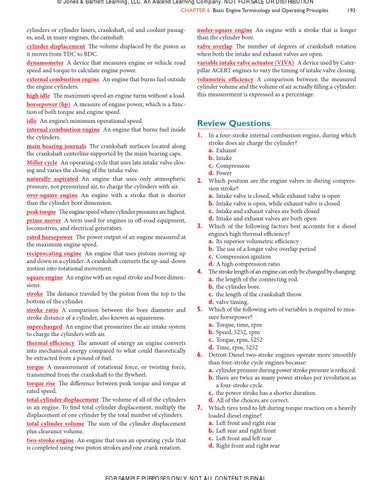© Jones & Bartlett Learning, LLC. An Ascend Learning Company. NOT FOR SALE OR DISTRIBUTION chapter 6 Basic engine terminology and Operating principles
cylinders or cylinder liners, crankshaft, oil and coolant passages, and, in many engines, the camshaft. cylinder displacement The volume displaced by the piston as it moves from TDC to BDC. dynamometer A device that measures engine or vehicle road speed and torque to calculate engine power. external combustion engine An engine that burns fuel outside the engine cylinders. high idle The maximum speed an engine turns without a load. horsepower (hp) A measure of engine power, which is a function of both torque and engine speed. idle An engine’s minimum operational speed. internal combustion engine An engine that burns fuel inside the cylinders. main bearing journals The crankshaft surfaces located along the crankshaft centerline supported by the main bearing caps. Miller cycle An operating cycle that uses late intake valve closing and varies the closing of the intake valve. naturally aspirated An engine that uses only atmospheric pressure, not pressurized air, to charge the cylinders with air. over-square engine An engine with a stroke that is shorter than the cylinder bore dimension. peak torque The engine speed where cylinder pressures are highest. prime mover A term used for engines in off-road equipment, locomotives, and electrical generators. rated horsepower The power output of an engine measured at the maximum engine speed. reciprocating engine An engine that uses pistons moving up and down in a cylinder. A crankshaft converts the up-and-down motion into rotational movement. square engine An engine with an equal stroke and bore dimensions. stroke The distance traveled by the piston from the top to the bottom of the cylinder stroke ratio A comparison between the bore diameter and stroke distance of a cylinder, also known as squareness. supercharged An engine that pressurizes the air intake system to charge the cylinders with air. thermal efficiency The amount of energy an engine converts into mechanical energy compared to what could theoretically be extracted from a pound of fuel. torque A measurement of rotational force, or twisting force, transmitted from the crankshaft to the flywheel. torque rise The difference between peak torque and torque at rated speed. total cylinder displacement The volume of all of the cylinders in an engine. To find total cylinder displacement, multiply the displacement of one cylinder by the total number of cylinders. total cylinder volume The sum of the cylinder displacement plus clearance volume. two-stroke engine An engine that uses an operating cycle that is completed using two piston strokes and one crank rotation.
193
under-square engine An engine with a stroke that is longer than the cylinder bore. valve overlap The number of degrees of crankshaft rotation when both the intake and exhaust valves are open. variable intake valve actuator (VIVA) A device used by Caterpillar ACERT engines to vary the timing of intake valve closing. volumetric efficiency A comparison between the measured cylinder volume and the volume of air actually filling a cylinder; this measurement is expressed as a percentage.
Review Questions 1. In a four-stroke internal combustion engine, during which stroke does air charge the cylinder? a. Exhaust b. Intake c. Compression d. Power 2. Which position are the engine valves in during compression stroke? a. Intake valve is closed, while exhaust valve is open b. Intake valve is open, while exhaust valve is closed c. Intake and exhaust valves are both closed d. Intake and exhaust valves are both open 3. Which of the following factors best accounts for a diesel engine’s high thermal efficiency? a. Its superior volumetric efficiency b. The use of a longer valve overlap period c. Compression ignition d. A high compression ratio 4. The stroke length of an engine can only be changed by changing: a. the length of the connecting rod. b. the cylinder bore. c. the length of the crankshaft throw. d. valve timing. 5. Which of the following sets of variables is required to measure horsepower? a. Torque, time, rpm b. Speed, 5252, rpm c. Torque, rpm, 5252 d. Time, rpm, 5252 6. Detroit Diesel two-stroke engines operate more smoothly than four-stroke cycle engines because: a. cylinder pressure during power stroke pressure is reduced. b. there are twice as many power strokes per revolution as a four-stroke cycle. c. the power stroke has a shorter duration. d. All of the choices are correct. 7. Which tires tend to lift during torque reaction on a heavily loaded diesel engine? a. Left front and right rear b. Left rear and right front c. Left front and left rear d. Right front and right rear
FOR SAMPLE PURPOSES ONLY. NOT ALL CONTENT IS FINAL 9781449624118_CH06_Pass02.indd 193
06/10/15 3:29 PM
